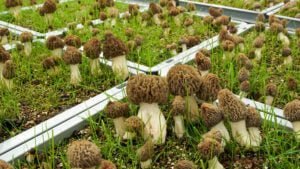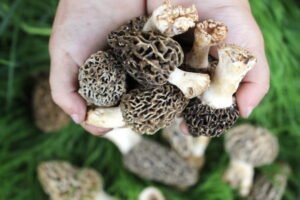Morel Mushrooms
The Morel mushroom is a mushroom with a characteristic hollow cap with a gap between the walls and stem. It is a common fungus found in gardens, disturbed ground and wood-chip beds. It is also occasionally found beneath Apple trees. Some species are found growing in short grass near conifers and other calcareous soils.
Buy A Morel Mushroom Grow Kit Today
Morchella punctipes
The Morchella angusticeps mushroom belongs to a family of fungi known as Morchella. It is native to eastern North America, and is very tasty. It also contains high amounts of essential minerals and vitamins. It can be quite rare in some years, but is often found in abundance during other times of the year. It looks similar to a pine cone and ripens from late May to late July in some regions.
In recent years, scientists have discovered that M. angusticeps is actually a distinct species. Until 2012, it was sometimes called M. elata. Although the two are similar in color, shape, and texture, they are different in a few important ways. The most obvious difference is the shape of the head, which is very small relative to the length of the stipe. It hangs over the stem like a skirt for about half of its length.
There are many subspecies of Morchella. Some species are European while others are native to North America. In fact, most species are found east of the Rocky Mountains. In North America, the most common are yellow and black, but there are also gray ones.
The Morchella genus consists of over 50 species with a high degree of endemism. In North America, there are 19 phylogenetic species, 14 of which are new. Several species have already been designated nomen dubium.
While Morchella species exhibit a variety of relationships with their habitats, many of them are closely related to trees. For instance, yellow morels are most common under deciduous trees, while black morels are more common in coniferous forests. Black morels are often found in disturbed ground and often appear to fruit during winter months.
Morchella punctipes in More fungi are edible and nutritious. They are a popular culinary treat and can be found throughout North America, eastern Europe, and Asia. The fruiting bodies are hollow and contain many insects and other living organisms. They grow well under trees, including tulip, white ash, green ash, pine, and poplar.

Check Out Our Morel Mushroom Spawn
Morchella angusticeps
The fungus Morchella angusticeps is native to eastern North America. It was first described by Charles Horton Peck in 1879. However, it wasn’t until 2012 that its name was clarified. It was previously known as M. angusticeps, but was also known by several other names.
Morchella angusticeps belongs to the clade Elata. It is most abundant east of the Rocky Mountains and is characterized by irregularly shaped ridges. It only grows in unburnt habitats and fruits singly. The genome is available for research purposes, but researchers must contact the PI if they plan to use it.
The ridges on Morchella angusticeps are darker than the pits. The pits start out yellowish brown and remain that color as the mushroom ages. Although this is a good way to distinguish it from other morels, there are other characteristics that make this mushroom different.
Morchella angusticeps is one of the larger varieties of morel mushroom. It can grow anywhere from 2.5cm to ninecm in height. Its head can be flat or curved, and its pits are elongated in a vertical direction. Its fruiting season is usually from March to May, depending on the weather.
Morchella angusticeps is a species of fungus that is native to eastern North America. It is one of the most sought-after edible mushrooms, and is often used in cream sauces. The fungus can also be dried and used later. This type of mushroom grows in damp areas and is often found in orchards.
Morchella angusticeps was previously held at the New York State Museum in the Mycological Collections Herbarium. However, the museum no longer had the resources to study the specimen further. As a result, the fungus was returned to its former location. Unfortunately, funding and staffing were cut from the museum. This resulted in the inability to study Morchella angusticeps properly.
While the family Morchella is comprised of edible species, its ecology is not well understood. Many species are mycorrhizal symbionts while others grow as endophytes inside the roots of plants. They are generally saprotrophs and are widespread throughout the northern and southern hemispheres.
Verpa bohemica
Verpa bohemica, also called the thimble-cap or early morel, is a species of fungus. Its cap is pale yellow and is about two to four cm in diameter. It hangs from a lighter colored stem that is about one to two cm thick. Verpa bohemica is widespread in northern North America.
Verpa bohemica is very similar to Morchella angusticeps but has larger spores. It was first described by Julius Vincenz von Krombholz in 1828. Schroter transferred Morchella angusticeps to the genus Verpa in 1893. Its synonym is PtychoVerpa bohemica.
Verpa bohemica is distinguished from Morchella punctipes by its cap, which hangs free and has a stalk attached to the bottom of the cap. Morchella punctipes, however, has a stalk attached about half-way up the cap. Both species are slightly poisonous and not authorized for collection in Michigan.
Verpa bohemica, formerly known as the false morel, has a distinct rDNA sequence. Its spores are elliptical and smooth, with a large number of nuclei (up to sixty).
Morchella angusticeps is native to eastern North America. Its edible fruit is a nutritious, tasty treat that contains high antioxidant levels and essential minerals and vitamins. It can be scarce in some years and abundant in others. The fruit of this fungus resembles a pine cone and ripens in late May or July. Its availability depends on the temperature and elevation.
Although many field guides regard Verpa bohemica as toxic, the truth is that it is not dangerous to eat. However, it should be handled properly to avoid contamination. There are some risks that come with eating it, including gastrointestinal issues, cerebellar syndrome, and temporary loss of coordination.
Morel mushrooms are very popular in areas of Ohio, including Ross county. However, hunters should be aware of false morels that can cause organ damage and life-threatening symptoms. For this reason, visitors are only allowed to collect up to 12 Morel mushrooms per visit.
Verpa species are closely related to morels and are often confused with them. Verpa mushrooms can also cause gastrointestinal discomfort and reduce muscular mobility, and therefore should be avoided in general.

Try Our Morel Mushroom Ready to Fruit Blocks Now!
Eastern black morel
The eastern black morel (Morchella angusticeps) is the classic black morel of eastern North America. This mushroom has a distinctive black cap with a vertical groove reminiscent of an ant raceway. It is also the only species of black morel in most parts of its range. A smaller species, called Morchella septentrionalis, is also found near rotting wood.
The Eastern black morel, Morchella angusticeps, grows only in eastern North America. Its honeycomb-like upper portion is made of pits in between the ridges. Despite its edible quality, morchellas have been associated with stomach upset and a burning throat. Its biological effects and mechanism of action are not yet clear.
Morchella angusticeps is native to the eastern US and Canada. This delicious mushroom has a high concentration of essential minerals and vitamins. It grows in many types of habitats and prefers the soil under hardwoods. It is also known as Gyromitra or Verpa.
The cap of this mushroom is a dark gray with a thin, vertically-oriented ridge. This mushroom grows up to two inches tall. Its fruiting season is March through May, before the yellow morels. The cap is typically pockmarked and the mushroom appears black and white at different stages of the life cycle.
The cap of the Eastern black morel is conical to oval, measuring from 1.6 to 4.3 inches (4 to 11cm) tall and 0.8 to 2.5 inches (2-6cm) wide. The morel is often known as a “spongy” mushroom. It is a member of the Morchella genus, related to anatomically simpler cup fungi. Its cap resembles a honeycomb, and has several pits interspersed between its ridges.
Another common type of morel is the white morel (M.snyderi). This mushroom grows in moist, disturbed areas, and it is unique in North America. It is an opportunistic species, and does not grow under trees. It is found in open fields and other disturbed places.
The fruiting body of the morel contains a sclerotium that protects the mycelium underground. Once the fungus is in the soil, it will only emerge when the conditions are right. The fruiting period for morels is from April through July. Its fruiting body contains spores that are used for reproduction.
We Have Only The Best Morel Mushroom Liquid Culture Available
